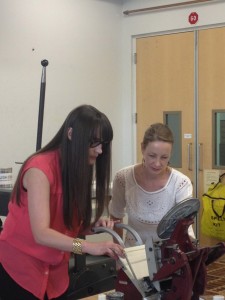Community
July 24, 2014
Adaptation
This being my first TEMiC, I wasn’t sure what to expect. It’s been awhile since I attended a course away from my home institution, and have really only travelled alone to briefly attend conferences. Add to this the uncanny phenomenon of re-encountering (after x years) the ‘residence experience’, wherein I shed the creature comforts of cable television, WiFi, and a private washroom. Not only that, but I couldn’t shake the sensation that my project and background as an artist/curator-slash student of Interdisciplinary Humanities are somewhat anomalous and amorphous when compared with those of other EMiC participants (I believe this is commonly referred to as ‘imposter syndrome’) and that this would alienate me, so, needless to say, I was nervous for the first official day of training.
This is where the complaints end. On Monday, the official start day of the course, I had been here for two nights and had adjusted to the ‘residence situation’. I had attended the welcome dinner and had found that I had much more in common with my fellow participants than expected, and felt must less insecure. The first day involved a discussion of some of the basic tenets of editorial theory, which are interesting in themselves, but it was really the discussion of our assigned readings that brought a sense of ease: theory, I can do.
Face-to-face seminar discussion, as fraught as it can seem when I tend to second-guess the unformed thoughts I impulsively share with the group, is one of the most productive forms of communication in a pedagogical environment, and can bring a sense of unity to an otherwise disjointed and multifarious group. Add to this a brilliant presentation by Jordan and David Stouck on their book project, “Collecting Stamps Would Have Been More Fun” (2010) and a print-making workshop (!!!) with the wonderful Briar Craig.

Tuesday was the day of my presentation on Susan Brown’s “Don’t Mind the Gap: Evolving Digital Modes of Scholarly Production across the Digital-Humanities Divide” (2011), and although I was disappointed to hear that Brown wasn’t able to attend the afternoon session at the UBCO theatre, there was an interesting dialogue between my analysis of Brown’s paper (implicating the related conversations of critical posthuman theorists N. Katherine Hayles and Rosi Braidotti) my colleague Nick’s presentation of the creation of the Watson Walk app from the EMiC lab at U of A, and EMiC director Dean Irvine’s lecture on the history of avant-garde laboratories and collaboration and subsequent workshop on the development of the Modernist Commons.
The debate between traditionalists and digital humanists is central in some ways to my doctoral studies, as I have encountered critical perspectives regarding my interest in technological mediation and digital infrastructures. Encountering such enthusiastic and well-wrought arguments reinforcing the objects my curiosity was extremely refreshing, particularly because the milieu of a textual editing course would seem to lean, epistemologically and ontologically, more towards a traditionalist model. The notion that digital humanities implicates the advancement of new forms of literacy and expressive form, building and improving upon existing models of dissemination, is oddly comforting. Knowing that a community of scholars shares these interests will propel our research forward.
Reflecting on the past few days and anticipating the next few days of the training institute, the overall theme that comes to mind is that of adaptation. Sure, we have adapted to residence life and each other (it was noted that our seminars have become progressively more lively and animated), but on a different level, we, as both humanists and scholars capable of change, have adapted our projects and our individual and more collective levels of consciousness to the evolving digital climate.
By Julia Polyck-O’Neill
